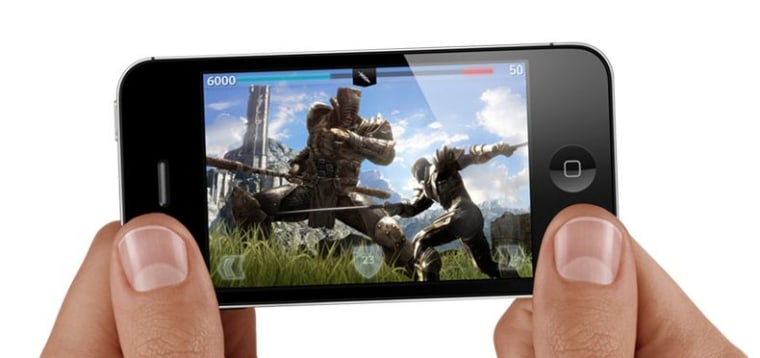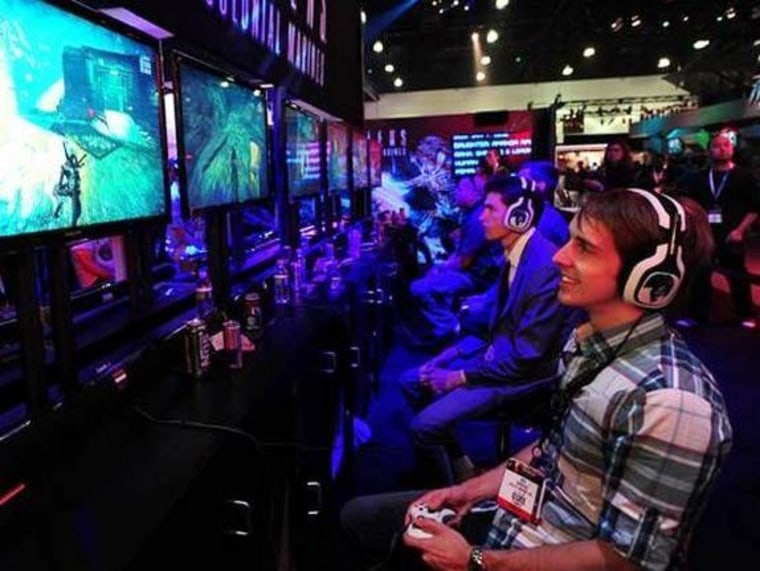
Considering all the new smartphones and tablets, not to mention the Xbox 360, the PlayStation 3 and the Wii, and don't forget the Vita and the Nintendo 3DS ... considering just how many machines we have to play games on these days, researchers have made a surprising find: During the last year, the number of people who play games in the United States has shrunk.
In a report released this week by market research company The NPD Group, analysts found that 211.5 million people in the U.S. — about two-thirds of the population — are playing games. It's a big number ... and yet it's 12 million less when compared to 2011.
But is that really the case? With the incredible proliferation of gadgets to play games on, are fewer Americans actually gaming? Are millions of people setting down their game controllers ... and are they setting them down for good?
Not everyone agrees.
"If you look at the data holistically — across all platforms and devices — I think it hard to believe that the number of people gaming is doing anything but dramatically increasing," Hal Halpin, president of the Entertainment Consumers Association, told me. (The ECA is a non-profit organization dedicated to gamer advocacy.)
The NPD report, titled "Gamer Segmentation 2012: The New Faces of Gamers," breaks players into six types — core gamers, mobile gamers, digital gamers, light PC gamers, avid PC gamers and family & kid gamers (for a in-depth definition of each, check out this GeekWire story). And according to the report, the number of people in all of those categories — except two — has declined.
That is, the number of mobile gamers (those who usually play on phones and tablets) and digital gamers (those who like to download their games) have increased in the last year, with mobile gamers growing by 9 percentage points to 22 percent of the total game-playing population, and digital gamers up 4 percentage points to 16 percent of the total.
That means that mobile gamers now outnumber the so-called core gamers (avid gamers who play especially on the Xbox 360 and PlayStation 3) — which is something of a landmark moment considering it's the core gamers who have traditionally been the most devoted and numerous game enthusiasts out there.
"Given the long lifecycles of the current consoles and the increasing installed base of smartphones and tablets, it's not surprising to see a slight decline in the core gamer segment," said Anita Frazier, an industry analyst with the NPD Group. (Though she noted in the report that core gamers still drop more money on games than any other kind of player.)
More game gadgets, fewer gamers?
But Halpin finds it difficult to believe that the total number of gamers in the United States has truly decreased.

"While I have a lot of respect for the NPD Group and the research that they do, their methodology can be flawed when looking at gamers and gaming in its totality," he said. "Years ago, I was fairly regularly asked by the media, 'Who is a Gamer?' and I think that question has been answered by the obvious: it's now easier to ask, who isn't?"
And his observations match my own: "With the ubiquity of tablets and phones, I'm hard-pressed to even think of someone I know who hasn't recently played a game," Halpin said.
NPD arrived at its findings after doing an online survey in March. They say the data is weighted and representative of the U.S. population ages 2 and older and is based on 8,488 completed surveys. As for the different types of gamers — Frazier explains that, for the purposes of the survey, people were assigned to one of the segments based on their overall behavior. But she explained, any gamer in one of their segments could play across multiple devices.
Indeed, Halpin believes that categorizing gamers is becoming increasingly difficult ... and problematic.
"While the definition of 'hard core' is certainly changing, as is our perception of what used to be referred to as 'casual' or 'social,' I think it's likely that we're simply seeing a melding of gamer types and gaming preferences," he told me. "The device and platform is less important now than it has ever been."
By way of example, consider the NPD finding that mobile gamers now outnumber core gamers. The NPD's "core gamer" category doesn't include the "avid PC gamers" -- who have been put into a separate category of their own. But in traditional gaming parlance, avid PC gamers are often considered the most hardcore of the core gamers.
So are core gamers actually outnumbered by mobile gamers? And what happens when a console gamer is also a PC gamer is also a mobile gamer — as so many of us are these days?
"I think that researchers are in a quandary, especially now, with how to identify types and categories of gamers," Halpin said. "I don't envy them the job, but researchers truly need to re-think their entire approach to identifying the demographic because the old models just don't work any more."
Halpin said he thinks researchers need to look at the gaming landscape like Generation Y does — "as content to be consumed."
"My kids love Star Wars. They'll read the books, watch the cartoons, play the games — any which way that they can access the content and via any readily-available medium," he explained. "They're completely platform agnostic, unlike Gen Xers. I can get into a good debate with our IT guys about Macs versus PCs, or with friends about Xbox vs PlayStation and yet none of those in Gen Y that I've talked with care. To them, the only differentiator between a tablet and a console is ease of access to the content they want."
Picking up the game controller again
While the total number of American gamers — or who actually qualifies as a core gamer for that matter — may be up for debate, one thing that is not: the ongoing decline of video game retail sales.
The NPD Group on Thursday released U.S. video game sales figures for the month of August showing that video game systems, game software and accessories sold $515.6 million, which is down 20 percent from August of 2011. Hardware sales alone were down 39 percent from August of last year.
As NPD's Frazier put it, "The current hardware systems are showing their age."
The fact of the matter is, the Wii, PlayStation 3 and Xbox 360 are all six and seven years old. In fact, the current console lifecycle has lasted longer than any previous. That means excitement over the machines has dwindled with time as has the number of new console games.
So perhaps some gamers are, in fact, setting their controllers aside. At least momentarily.
But as we here at InGame noted after attending the (seemingly subdued) Electronic Entertainment Expo earlier this year: this could simply be the calm before the storm.
With Nintendo's brand new Wii U launching sometime later this year and many expecting both Microsoft and Sony to launch new game consoles of their own next year, it looks like gaming (and the gaming population) could see a boom very soon.
I asked Frazier if she expects the downward turn the NPD found in the number of American gamers to turn back around with the launch of the Wii U this fall and with (presumably) a new Xbox and PlayStation next year.
Her response: "Yes, I would expect this to change again with the launch of new hardware which will reinvigorate traditional gaming."
Winda Benedetti writes about video games for NBC News. You can follow her tweets about games and other things on Twitter here @WindaBenedetti, and you can follow her on Google+. Meanwhile, be sure to check out the IN-GAME FACEBOOK PAGE to discuss the day's gaming news and reviews.
